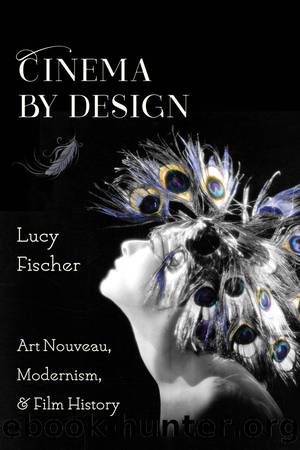Cinema by Design by Lucy Fischer;

Author:Lucy Fischer;
Language: eng
Format: epub
Publisher: Lightning Source Inc. (Tier 3)
3.4 The opening title of Costa Brava (1995, Marta Balletbò-Coll) depicts the facade of Antoni Gaudí’s Casa Milà in Barcelona.
Interestingly, tourism itself is at the heart of another film set in Barcelona, though in the post-Franco era—Costa Brava, directed by Spanish filmmaker Marta Balletbò-Coll. It is an innovative, independently made romantic comedy, which was shot in fourteen days with donated 35-millimeter film stock. It concerns Anna (played by the director), who is a tour guide in Barcelona, and we intermittently see her on a bus talking to tourists, who always remain off-screen. Ironically, we do not have any extended sequences of her leading tours to famous Gaudí sites, which are usual stops on this kind of trip. Throughout the film, however (as well as in the opening title sequence that depicts Casa Milà), we get other brief glimpses of the architect’s creations: Casa Batlló, Casa Milà, the Park Güell (see figure 3.4).
The one site that receives considerable attention is La Sagrada Família, which we see intermittently in fleeting images, but also more regularly from the rooftop of Anna’s residence. In addition to being a tour guide, she is a playwright; and throughout the film we see her perform original “monologues” on her roof—part of a work she has entitled “Love Thy Neighbor.” In the background, obscured by clothes hanging on lines and TV antennas, we see the spires of La Sagrada Família.
When we first witness Anna enacting a monologue (by speaking directly to the camera), we do not realize that it is a theatrical piece and that she is performing a role. Later on, we see people filming her and holding cue cards, so we begin to understand the context. The title of her play is rather ironic, since in these scenes she often complains about her lesbian neighbor. She is surprised, for instance, that the woman is in finance and not a sports figure (“They’re everywhere!” she exclaims). In another rant, she is shocked that the woman does not conduct orgies and opines that her lesbianism may be due to deficient hormones. In these sketches Anna also talks about her husband Carlos. In fact, Anna is unmarried, and her vignettes are entirely fictional and tongue-in-cheek. At least at the onset of the film, not much love is lost on her fellow apartment dwellers.
Despite teasing us by invoking Gaudí’s buildings while withholding them from sight, the film makes them a central part of the film’s setting and atmosphere—not surprising for a work about tourism. What is interesting is that, like The Passenger and Biotaxia, the film foregrounds issues of fluid identity and opposition to the restrictions of habitual bourgeois life. As we have seen, these are themes associated with Art Nouveau.
In the course of Anna’s professional duties, she meets a younger Israeli woman who has grown up in the United States, Montserrat (Desi del Valle). On the day of her tour, Montserrat develops a headache; Anna tells her to wait behind and hands over her pocketbook, which contains aspirin. When Montserrat looks inside the handbag she also finds a copy of Anna’s monologues, which she peruses.
Download
This site does not store any files on its server. We only index and link to content provided by other sites. Please contact the content providers to delete copyright contents if any and email us, we'll remove relevant links or contents immediately.
| Decorative Arts | Design History & Criticism |
| Furniture Design | Industrial & Product Design |
| Interior & Home Design | Jewelry Design |
| Textile & Costume |
POP by Steven Heller(2883)
Japanese Design by Patricia J. Graham(2555)
The Power of Broke by Daymond John(2376)
Architecture 101 by Nicole Bridge(2350)
Fusion 360 for Makers by Lydia Sloan Cline(1987)
Indistractable: How to Control Your Attention and Choose Your Life by Nir Eyal(1936)
Origami Art by Michael G. Lafosse & Richard L. Alexander(1734)
Actionable Gamification: Beyond Points, Badges, and Leaderboards by Yu-kai Chou(1721)
Batik by Rudolf Smend(1719)
Homebody by Joanna Gaines(1711)
Worn in New York by Emily Spivack(1618)
Feng Shui by Stephen Skinner(1616)
Whiskey in a Teacup by Reese Witherspoon(1576)
Austin Kleon by Steal Like an Artist(1537)
Don't Make Me Think, Revisited: A Common Sense Approach to Web Usability by Steve Krug(1527)
Simple Gatherings by Melissa Michaels(1511)
Hygge: The Danish Art of Happiness by Marie Tourell Søderberg(1427)
The Joy of Hygge by Jonny Jackson(1341)
The Laws of Simplicity by John Maeda(1300)
